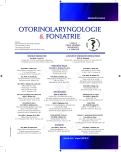Sialoendoscopy in Diagnostics and Therapy of Submandibular Sialolithiasis
Authors:
P. Štrympl 1; L. Staníková 1; P. Matoušek 1,2; T. Pniak; P. Komínek 1,2
Authors‘ workplace:
ORL klinika, FN Ostrava, přednosta prof. MUDr. P. Komínek Ph. D., MBA
1; Lékařská fakulta Ostravské univerzity
2
Published in:
Otorinolaryngol Foniatr, 64, 2015, No. 3, pp. 157-162.
Category:
Original Article
Overview
Introduction:
Sialendoscopy is a modern interventional method used in management of submandibular salivary gland sialolithiasis.
Aim of the study:
Assessment of the sialendoscopic treatment of the submandibular stones.
Patient and methods:
One hundred and thirty-four sialendoscopies were performed at ENT Clinic University Hospital in Ostrava between 2010 – 2013. Sixty-two sialoliths were verified. Thirty-four sialoliths were localised in distal parts of submandibular duct and 28 patients were treated for lithiasis of proximal part of Wharton’s duct. All these patients underwent sialendoscopic treatment.
Results:
Sialendoscopic extraction interventions with wire basket or forceps were successful in 31(91.2 %) patients. Transoral removal in patients with proximal lithiasis was successful in 23 patients (82.1 %). Sialadenectomy was performed in 3 patients (10.7 %) after transoral removal and in 1 after sialendoscopic extraction. Indication criteria for sialadenectomy were persisting problems after treatment and failure of the transoral removal. Sialadenectomy was performed in 4/28 (14,3 %) patients from whom wasn´t tolerate local anaesthesia.
Conclusion:
Sialendoscopy is presented as gland-preserving method and it is conducted with lower number of complications contrary to standard surgical methods. This mini invasive method is more efficient than standard treatment and recovery period after surgery is shorter.
Keywords:
sialolithiasis, benign obstructive disease, submandibular salivary gland, sialendoscopy, transoral removal
Sources
1. Bradley, P. J., Huntinas-Lichius O.: Salivary gland disorders and diseases: Diagnosis and management. Thieme, Stuttgart, 2011, ISBN: 9783131464910.
2. Brown, J. E.: Minimally invasive techniques for the treatment of benign salivary gland obstruction. Cardiovasc. Intervent. Radiol., 26, 2002, s. 345-351.
3. Capaccio, P., Torretta, S., Pignataro, L.: The role of adenectomy for salivary gland obstructions in the era of sialendoscopy and lithotripsy. Otolaryngol. Clin. North Am., 42, 2009, 6, s. 1161-1171.
4. Fritsch, M. H.: Sialendoscopy and lithotripsy. Otolaryngologic. Cloníc. of North America, 2009, 6, s. 915-1229.
5. Mc Gurk, M., Makdissi, J., Brown, J. E.: Intra-oral removal of stones from the hilum of the submandibular gland: report of technique and morbidity. Int. J. Oral Maxillofac. Surg., 33, 2004, s. 683-686.
6. Ianovski, I., Morton, R. P., Ahmad, Z.: Patient-perceived outcome after sialendoscopy using the glasgow benefit inventory. Laryngoscope, 2013, Epub ahead of print.
7. Iro, H., Zenk, J., Escudier, M. P., Nahlieli, O.: Outcome of mininally invasive management of salivary calculi in 4,691 patients. Laryngoscope, 119, 2009, s. 263-268.
8. Koch, M., Zenk, J., Iro, H.: Algorithms for treatment of salivary gland obstructions. Otolaryngol. Clin. North Am., 42, 2009, 6, s. 1173-1192.
9. Koch, M., Iro, H., Zenk, J.: Sialendoscopy – based diagnosis and classification of parotid duct stenoses. Laryngoscope, 119, 2009, s. 1696-1703.
10. Koch, M., Iro, H., Klintworth, N., Psychogios, G., Zenk, J.: Results of mininally invasive gland-preserving treatment in different types of parotid duct stenosis. Arch. Otolaryngol. Head and Neck Surg,, 138, 2012, s. 804-810.
11. Koch, M., Zenk, J., Bozzato, A., Bumm, K., Iro, H.: Sialoscopy in case sof unclear swelling of major salivary glands. Otolaryngol. Head Neck Surg., 133, 2005, s. 863-863.
12. Koch, M., Zenk, J., Iro, H.: Diagnostic and interventional sialoscopy in obstructive disease of the salivary glands. HNO, 56, 2008, 2, s. 139-144.
13. Kopec, T., Wierzbicka, M., Szyfter, W., Leszynska, M.: Algorithm changes in treatment of submandibular gland Sialolithiasis. Eur Arch. Otorhinolaryngol, 270, 2013, s. 2089-2093.
14. Marchal, F., Dulguerov, P., Becker, M., Barki, G., Disant, F., Lehmann, W.: Specificity of parotid sialendoscopy. Laryngoscope, 111, 2001 , 2, s. 264-271.
15. Marchal, F., Dulguerov, P., Becker, M., Barki, G., Disant, F., Lehmann, W.: Submandibular diagnostic and interventional sialendoscopy: new procedure for ductal disorders. Ann. Otol. Rhinol. Laryngol., 111, 2002, 1, s. 27-35.
16. Nahlieli, E.: Modern management preserving the salivary glands. Isradon Izrael, , 2007, s. 149, IBSN 978-5-94467-050-2.
17. Nahlieli, O., Nakar, L. H., Nazarian, Y., Turner, M. D.: Sialoendoscopy: A new approach to salivary gland obstructive pathology. J. Am. Dent. Assoc., 137, 2006, s. 1394-1400.
18. Strychowsky, J. E., Sommer, D. D., Gupta, M. K., Cohen, N., Nahlieli, O.: Sialendoscopy for the management of obstructive salivary gland disease. Arch. Otolaryngol. Head Neck Surg., 138, 2012, 6, s. 541-547.
19. Štrympl, P., Komínek, P., Pniak, T.: Sialendoskopie – nová metoda v diagnostice a léčbě benigní obstrukční choroby slinných žláz. Endoskopie, 20, 2009, 1, s. 29-33.
20. Zenk, J., Koch, M., Bozzato, A., Iro, H.: Sialoscopy - initial experiences with a new endoscope. British Journal of Oral and Maxillofacial Surgery, 3, 2004, s. 1-6.
Labels
Audiology Paediatric ENT ENT (Otorhinolaryngology)Article was published in
Otorhinolaryngology and Phoniatrics

2015 Issue 3
Most read in this issue
- Phoniatric Care for Patients with Temporary or Permanent Vocal Cord Paralysis Following Operations on the Thyroid Gland
- Juvenile Angiofibroma of Nasopharynx
- Sialoendoscopy in Diagnostics and Therapy of Submandibular Sialolithiasis
- Revision Septorhinoplasties
